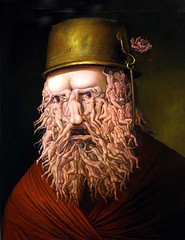On the Possibility of Conservative Literary Criticism
via Acephalous by Scott Eric Kaufman on Feb 27, 2007
Actually, Scott’s post is more about the possibility of a literary canon tout court. He says: “few believe that Shakespeare, Tolstoy or Melville shouldn’t be taught—that’d they’re somehow inadequately “literary” in some regard—only that they should be taught alongside Behn [amatory fiction, women’s lit], (George) Eliot [women’s lit] and Stowe [Uncle Tom].” He recognizes place and time constraints: “Practical issues obviously abound. I’m talking about the hypothetical canon here, not what can be covered in a ten or eighteen-week survey.”
Shakespeare is universal because he embraced cultures and traditions outside his own—although his argument suffers here from being too quick on the triumphalism. …But then there’s the problem of what else should be included in the canon. We all agree that Shakespeare should, but what about all those books written by brown people who live on islands we’ve never even heard of. Can they possibly produce great literature. …
there’s absolutely no reason [Erna] Brodber‘s Jane and Louisa Will Soon Come Home couldn’t be a work of “universal” genius. Were someone to argue that “our” cultural tradition isn’t represented, the claim to universality could be wielded as a multicultural cudgel: It doesn’t matter, we could say, swinging, because it tells a universal story, as applicable to us and our lives as any native Jamaican.
….
none of the usual critics of academia have attempted to define the literary in such a way that Shakespeare and Dickens are in, but Brodber and the rest are out. Or, they could have the courage of their convictions and say that if Shakespeare and Dickens are in, so are Brodber and the rest …
In this respect, I think the multiculturalist have cornered the cultural traditionalists, forcing them into a position either visibly incoherent (the false universalism of Shakespeare) or spectacularly racist (Dead and White, That’s What’s Right! Dead and White, That’s What’s Right!). ….
To conclude Scott asks: Where do they go from here?
Essentially, Acephalous is in search of a postmodern canon. A canon that gives a place to the other; the queer, the postcolonial. He’s not denying the justifiability of the Western canon, but wonders how big a place should be reserved for the ‘other’ within that canon, without deviating too far from the what-is-ness of things. I look forward to reading more.











